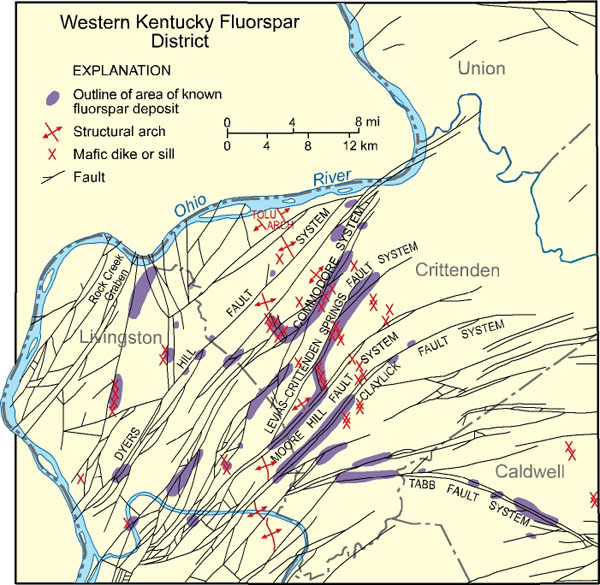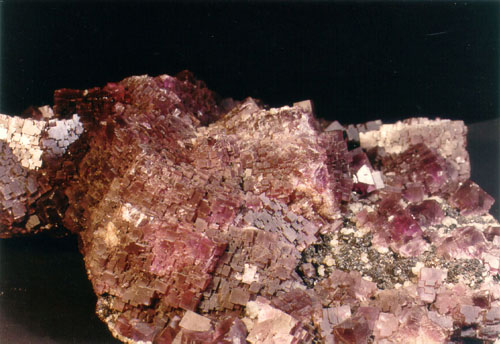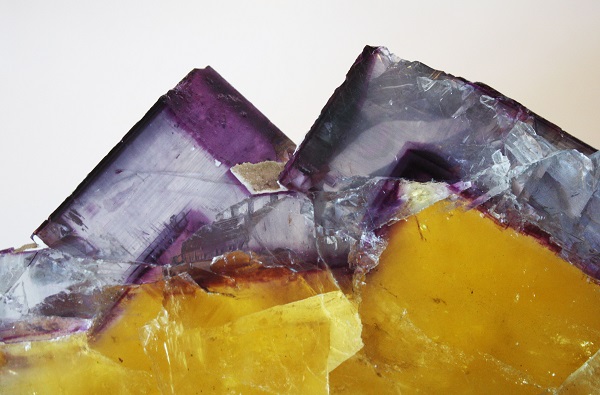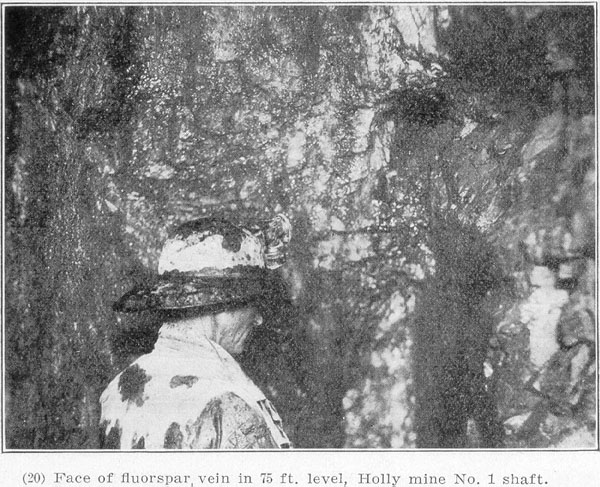Western Kentucky Fluorspar District
The Illinois-Kentucky Fluorspar District is located in Hardin and Pope Counties in southeastern Illinois and in adjacent Crittenden, Livingston, and Caldwell Counties of western Kentucky, within the Paducah 30 x 60 minute quadrangle. The Kentucky portion of this district is called the Western Kentucky Fluorspar District.
Until the 1970s, more than three-fourths of the fluorspar produced in the United States came from the Illinois-Kentucky Fluorspar District, which was the largest producer of fluorite in the United States during World War II. Most of the mining recovered the surficial residual deposits that accumulated above the vein deposits and ore deposits in the shallow subsurface; however, there is still a substantial reserve of fluorspar and zinc in additional deposits, both in underexplored surface areas and in deeper deposits. Since about 1970, foreign imports could be acquired more economically, so mining activity was drastically reduced in the district. Substantial quantities of zinc and some lead and barite have also been produced in the district, usually as a byproduct of fluorspar mining.
KGS has published numerous geologic maps, reports, and cross sections and led many field trips to investigate the district. KGS and the U.S. Geological Survey mapped the district at a scale of 1:24,000, and KGS has converted these maps into digital format for the Kentucky portion of the fluorspar district. The KGS Minerals Database contains abundant information on all of the ore deposits in the Western Kentucky Fluorspar District.

History and Production
The earliest mining in the district was for lead at the Columbia Mine, Crittenden County, in 1835 (Ulrich and Smith, 1905, p. 115). From 1835 to the early 1870s, little fluorspar was mined. Only small amounts were produced from the early 1870s to about 1890, when an expanded market was created by the development of the basic open-hearth steel furnace in which fluorspar was used for flux. Production since 1890 had been erratic, but in general had risen. Until the early 1930s, almost the entire production in the Illinois-Kentucky district was from vein ores. Production during World Wars I and II and the Korean conflict rose sharply, but because of rising imports from 1935 to 1938, production in the district decreased. In Kentucky, practically all production has been from veins and weathered residuum above veins, although the bedded deposit near Joy and Carrsville has been known since the 1950s and was put into production in 1970. Silica content and beneficiation problems closed the mine after a few years. Bedded deposits constituted most of the production in Illinois during this period, as vein deposits became depleted. Production rose in 1970, but declined rapidly, and all mine production ceased in Kentucky by 1985. Sporadic milling of recycled government stockpiles continued into the 1990s. Exploration is intermittent in the district, and currently there is one operating mine, the Klondike II, in Livingston County. Zinc has been produced for many years in a couple of veins such as the Hutson and Old Jim, and around 1940 the district became a major source of zinc, some as a byproduct of fluorite mining, some as a main product. Substantial quantities of barite have also been produced at the Mico, Ainsworth, and Pygmy Mines. Other major fault systems with associated fluorite are the Dyer Hill, Levias-Crittenden Springs, Commodore, Moore Hill, Claylick, and Tabb. Lead has been a minor byproduct in recent years, as have silver, cadmium, and germanium.



Classification of Mineral Deposits
There are three classes of mineral deposits in the Paducah 30 x 60 minute quadrangle, some of which are considered Mississippi Valley-type (MVT) hydrothermal mineral deposits. The first type is MVT, as described by Ohle (1980) are very narrow, vein-mineral deposits that extend vertically and horizontally for hundreds of feet and consist of fluorite, sphalerite, calcite, barite, and galena. The second type is strata-bound or bedded deposits, also classified as MVT, and containing fluorite, which occurs mainly in the Joy and Carrsville, Ky., area, and possibly bedded sphalerite in other areas of the district. The third type of mineral deposits is most unusual and is associated with igneous dikes. Rare earth elements occur in these igneous dikes and current research by Warren Anderson at KGS suggests REE enrichment; but more research is needed on the rocks. These igneous rocks are similar to Hicks Dome, an igneous intrusive carbonatite complex (Mariano, 1989) located in Hardin County, Ill., which is also a host for fluorite mineralization. There are other alkalic intrusives in the district, one example being an ultramafic intrusive called the Coefield Ultramafic Complex in Crittenden County. Associated mineralization is uncertain in the Coefield Ultramafic Complex, but could include fluorite or sphalerite. There could also be other mineralization, and if the complex is determined to be kimberlite or lamproite, it may contain diamonds.
The vein and strata-bound deposits were formed during the Permian Period by upward-migrating, fluorine-rich hydrothermal fluids that flowed along the fault planes of the northern New Madrid Fault System, extending north and east to Illinois and Indiana. Basinal hydrothermal fluids mixed with magmatic gases, and fluids generated by the Hicks Dome intrusive event were the dominant source of mineralizing fluids. Vein deposits occur along faulted areas, and most veins are lenticular and trend northeast in Mississippian carbonate rocks. Veins varying in width from 3 to 10 feet swell along strike for several hundred feet, and have been mined to a depth of 800 feet. Fluorite is the dominant mineral deposited in the district, but barite, sphalerite, and galena have been produced in smaller quantities. Some sphalerite mineralization is associated with mafic dikes at the Hutson Mine along the Big Sandy Creek Fault System, and smithsonite, a zinc carbonate, occurs at the Old Jim Mine near the Crittenden Springs Fault System.
Bedded (manto) deposits occur along the Rock Creek Graben near Carrsville, and are generally 5 to 200 feet wide, and can be 20 feet thick. Lengths range from 200 feet to 2 miles, and ore averages 20 to 35 percent fluorite (Goldhaber and Eidel, 1992). Other areas of bedded fluorite contain higher grades.
Igneous Intrusion Complex and Rare Earth Elements
The igneous intrusive complex of alkaline ultramafic rocks in the Western Kentucky Fluorspar District is slightly enriched in rare earth elements and contains rare minerals, including garnets. Rare earth elements are lanthanum, cerium, praseodymium, neodymium, promethium, samarium, europium, gadolinium, terbium, dysprosium, holmium, erbium, thulium, ytterbium, and lutetium; usually, yttrium and scandium are also included in this suite of minerals. Whole-rock elemental analysis of some of the dikes shows some of the dikes are slightly enriched in light REE. New research and more detailed information about the REE content and mineralogy of these rocks will be published in an upcoming report. Within the family of dikes, some contain rare minerals and some contain high lanthanum/ytterbium values, suggesting variable deep seated origin of mineralization in the district. Several of these rare minerals have never been identified in the Western Kentucky Fluorspar District and suggest complex mineralization.
There are several magnetic anomalies in the igneous rocks in the district. The most dominant feature was discovered by Billiton Minerals in the early 1980s along Coefield Creek. It is characterized as a lamprophyre and as a peridotite and carbonated kimberlite ultramafic intrusive. Numerous companies have examined the area for diamond potential, but no diamonds have been found. This intrusive is located southeast of Hicks Dome in northern Crittenden County, and there is another magnetic anomaly south of Coefield near Maple Lake in southern Crittenden County. These ultramafic and carbonatite complexes are characterized by igneous alkalic explosive breccia bodies and are discussed in Plumlee and others (1995) and Heck and others, (2006). A new report on the rare earth element potential of the igneous dikes in western Kentucky is under review.
Origin of Deposits
The vein and bedded deposits were formed by a release of fluorine-rich fluids from deep-seated alkalic intrusive rocks and by the intersection of these magmatic fluids with hydrothermal basinal fluids that were rich in base metals such as sphalerite, galena, and barite. These interactions of magmatic and hydrothermal fluids generated an acidic hydrothermal fluid and the fluorite mineral deposits (Plumlee and others, 1995). At the time of the initial explosive magmatic event that created Hicks Dome, north-migrating hydrothermal brines intersected with hot, fluorine-rich magmatic gases, resulting in precipitation along isothermal reaction paths in the fault systems (Plumlee and others, 1995). Paragenetic studies by Hayes and Anderson (1992) suggest that these magmatic/hydrothermal fluids were part of a regional system of mineralization that correlates with the Central Tennessee Zinc District and the Central Kentucky Mineral District.
Museum Displays
Many museum-quality specimens of fluorite and calcite have been obtained from the mines in the district and are some of the best in the world. Secondary minerals such as smithsonite, cerrusite, celestite, hemimorphite, greenokite, and pyromorphite also occur in the deposits (Anderson, 1994). The Clement Museum in Marion, Ky., contains some of the finest fluorite specimens in the world. The lobby of the Mining and Mineral Resources Building on the University of Kentucky campus contains fluorite specimens from many of the old mines, including some of the Clement collection on loan to KGS.
